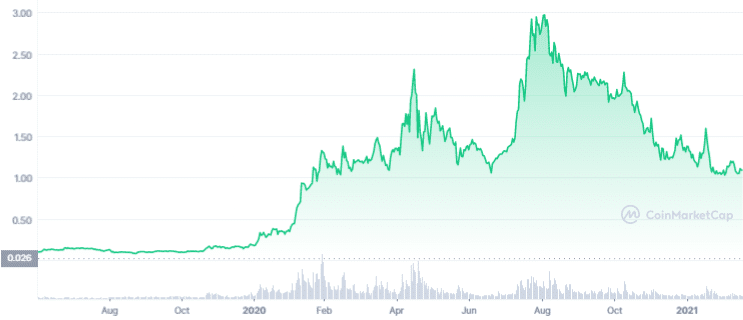Cardano (ADA) is one of the leading smart contract platforms on the market, but it started to lose ground to other projects when it started to delay and fail in promised deliveries.
In 2021, ADA performed remarkably, seeing its price jump from $0.17 on Jan. 1 to an all-time high of $3.10 on Sept. 2, up over 1,700%. However, the cryptocurrency has since dropped nearly 65% to its current price of $1.09.
But is it still worth investing in Cardano?
Experts believe so. But they point out that this depends on a few factors, including right time to buy and trading strategy.
Launched in 2017 by ETH co-founder Charles Hoskinson and powered by the ADA cryptocurrency, the Cardano network has the ability to run decentralized financial applications and read smart contracts.
As highlighted by cryptocurrency expert, Paulo Aragão, Cardano can be defined as an “Ether altcoin”. That is, a digital currency – and platform – alternative to the ETH network. This is because one of its purposes is to solve problems faced by the ETH network, such as scalability and transaction validation.
The big problem of the project, according to Aragão, is the speed of development and deliveries foreseen in the Roadmap:
“Despite having appeared in 2017, Cardano has not yet delivered things promised in past moments and, in some deliveries made, left something to be desired.”
In fact, the Cardano network has frustrated investors in its deliveries. In September 2021, for example, the network implemented the Alonzo Hard fork, which allowed the implementation of smart contracts on the network.
However, Minswap, the testnet’s first decentralized application, had concurrency issues at launch.
The flaw was criticized by programmer Anthony Sassano, who mocked the project’s scientific process:
“Six years of ‘peer-reviewed’ research and a market cap of $90 billion later, the first dapp on Cardano can’t even do concurrent transaction processing (aka the same thing you need to the DeFi).”
Last December, Cardano again disappointed with the launch of its first decentralized exchange (DEX), SundaeSwap, a highly anticipated launch. However, Cardano frustrated community expectations when he announced that DEX would be released as a testnet.
Path opposite to ease
Despite delays and failures, all is not lost for Cardano. According to the cryptocurrency expert and host of the BitNada channel, Felipe Escudero, this delay is, in a way, natural.
That’s because the team behind the Cardano network chose to start from scratch:
“Most blockchains focused on smart contracts are based on ETH Virtual Machine (EVM). Thus, the code library is already all written, tested and validated. Cardano, however, preferred to make its own from scratch, without relying on third-party codes. As a result, the deliverability of smart contracts is much slower.”
Escudero noted that the community is in a hurry as there are blockchains created from the ETH network that work the next minute. However, Cardano chose to “go the opposite route to ease”.
Is it worth investing in Cardano?
While the current momentum is bearish for Cardano – as well as for most major cryptocurrencies – ADA could be a good long-term investment.
This is what trader and investor Augusto Backes believes. According to him, Cardano is one of the best projects on the market in terms of decentralization, reliability and development team.
In addition, the trader pointed out that the Cardano team’s proposal to take the project to African countries, such as Tanzania, Ethiopia and Nigeria, where the population does not have access to the financial system, is optimistic for ADA in the long term.
In the short term, Backes pondered that the cryptocurrency is close to losing the $1 support. And if that happens, it could go as low as $0.50 or less. So he doesn’t think it’s a good option to expose himself to ADA at this point, especially since the cryptocurrency hasn’t reached a bottom and because BTC is in a downtrend:
“I generally like to expose myself to altcoins when BTC is in a weekly uptrend. If the trend is down, I run away from altcoins because they tend to depreciate a lot.”
For Backes, ADA should only rise again when, in fact, it manages to launch a concrete and usable DeFi ecosystem. That is, no delays and no network congestion.
Who agrees with Backes is Aragon. The expert pondered that, despite everything, he maintains some exposure to altcoin for the long term:
“Particularly, I keep some exposure in ADA because the project is relatively solid. Whether it will deliver everything it promises, we still don’t know. That will depend on the team. But if it does, it might have some future.”






















